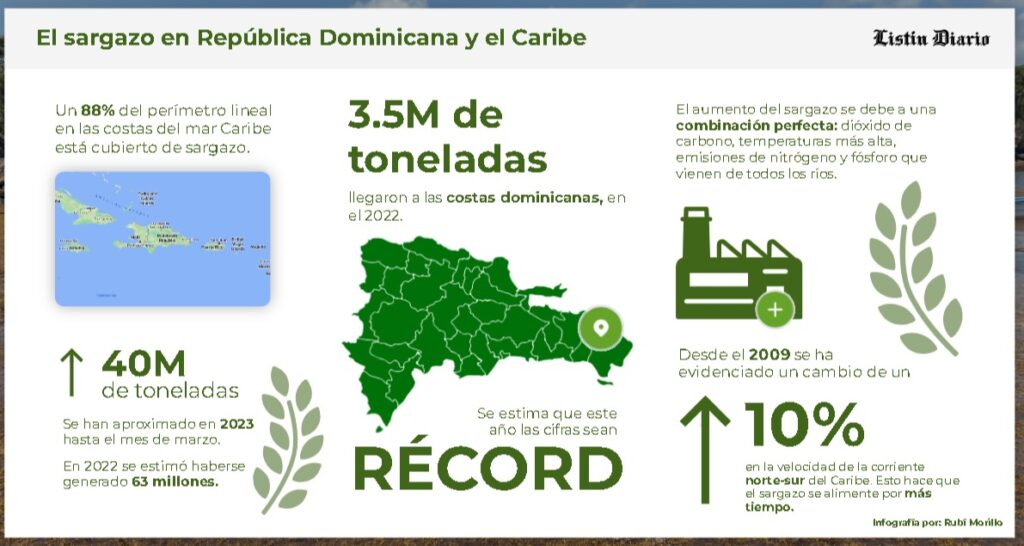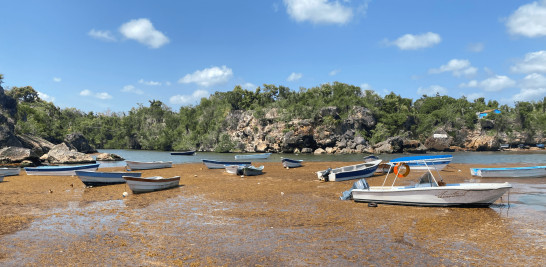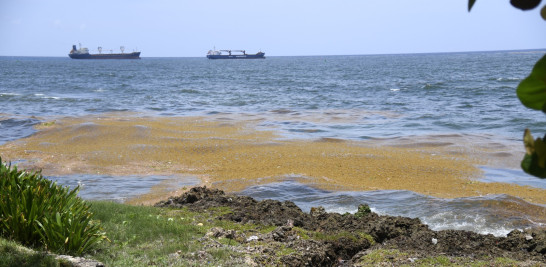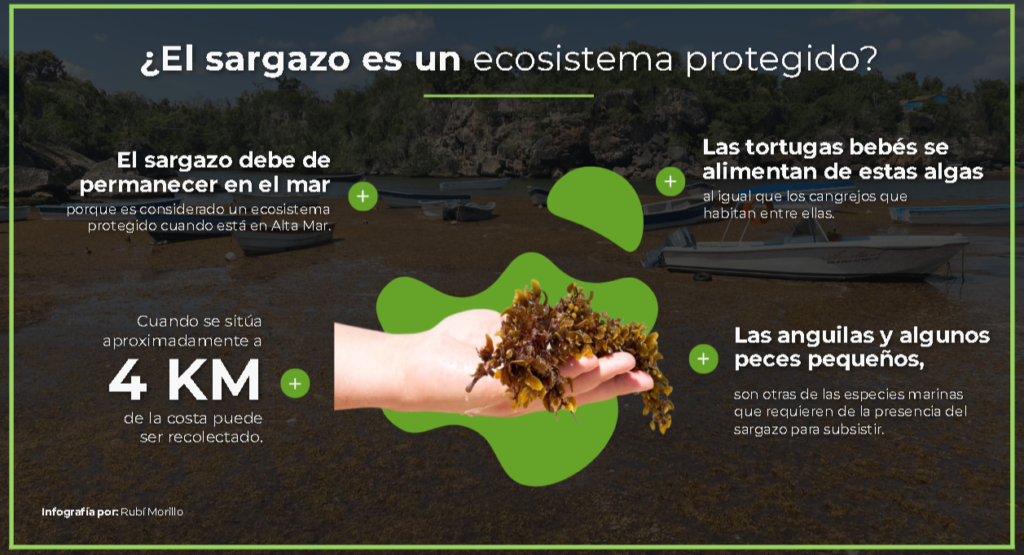This story was originally published by Listin Diario and won our Caribbean Climate Justice Journalism Awards, under the Best Solutions-Oriented Climate Story category. 🏆
—-
In recent years, the presence of sargassum has increased, affecting the good development of tourism, one of the main economic activities of the Dominican Republic and other nations in the Caribbean region.
These algae occupy approximately 88 percent of the linear perimeter on the coasts of the Caribbean Sea, affecting the livelihoods of some 13 countries in the region, according to the Ministry of the Environment.
Until March of this year, 40 million tons have been estimated, unlike 2022, in which it was estimated that about 63 million tons were generated throughout the year. About 3.5 million tons will arrive on the Dominican coast in 2022. For this year, it is estimated that the numbers will be higher. Commonly, these seaweeds are seen as a problem due to the damage they cause to marine life and ecosystems, in addition to disturbing the image of beaches and dirtying their white sands.
Despite these disadvantages, sargassum has properties that can be used as a raw material to produce multiple sustainable products, ranging from activated carbon to livestock feed, fertilizers, dyes, biofuel, concrete blocks, and thermoacoustic panels for construction. In the Caribbean, there are four varieties of sargassum, of which two species currently reach the country’s coasts: natans and fluitans, which contain nutrients such as phosphorus.

Building Blocks
Using sargassum in the construction sector is one of the advantages that this seaweed has. Their high potential in thermal conditions is favorable for including them in the production of concrete blocks to reduce heat. Since 2019, the School of Civil and Environmental Engineering of the Pontificia Universidad Católica Madre y Maestra (PUCMM) has been developing a research project led by civil engineer Yokasta García, which would promote sargassum as a useful element for sustainable and low-cost construction.
She mentioned that in Mexico they use sargassum to make bricks, and based on these experiences, they are checking the possibilities that exist that can be introduced into the country’s construction sector, obviously adapting it to the temperatures and environments of the Dominican Republic. García explained that to obtain the raw material from sargassum and then join it with the concrete mixture, it is collected directly from the sea, then double washed, dehydrated to demolish it, and, finally, powdered.
As part of the research, the academy has a “facade characterization and real scale” laboratory, where they have three modules composed of the simulation of three houses where the concrete blocks made with sargassum and thermoacoustic insulating panels will be assembled. These will exhaust an evaluation and measurement process for a certain time to check their effectiveness and resistance.
Once tested, these panels would be used to cover the entire structure of a house so that freshness is maintained, and heat does not penetrate the home. This material will not be visible but will be introduced into the blocks.

Activated Carbon
Since 2016, phosphorus has been used by experts and researchers from the Santo Domingo Technological Institute (Intec), who produce “activated carbon” made from sargassum. Carlos Sanlley, director of research at the university, explained that the positive parts of sargassum “are very broad” and can be used to do “many things,” after evaluating which ones are conducive to different areas of the country.
He highlighted that the university is adding other components to activated charcoal to see the possibilities of turning it into soap. He explained that this product is usually used in water treatment plants with the objective of absorbing heavy metals and purifying the liquid. Activated carbon is characterized by being “black stones” that are placed in filters.
Cattle Food
Another of the positive parts that sargassum has is the amount of micro- and macronutrients, which could be used to convert it into livestock food to replace grass in dry seasons. According to a research project being developed by the Pedro Henríquez Ureña National University (UNPHU), the nutrient potential of sargassum is high and could become a nutritional supplement for cattle. Ramón Sánchez, one of the researchers, said that his studies found nutrients such as calcium, potassium, iodine, manganese, fiber, and proteins that can be essential elements in the creation of food.
The final product would be marketed in granules after exhausting its manufacturing process, which is based on washing, drying, grinding (until it becomes a fine powder), and finally adapting it to its presentation. The nutrients from sargassum will be linked to other agro-industrial waste, for example, avocado pulp, after extracting the oil produced by some industries. In addition to the stems of bananas and other plants. Once created, its use would not be limited to livestock but could be used to feed other animals after experiencing the behavior and reaction to this type of food.
He highlighted that in Mexico, sargassum is used to increase the level of iodine in livestock by preparing a supplement. In addition to the flour that is used to make tortillas and is for human consumption, he also explained that substances for dyes and fibers could be extracted from sargassum.
Action Plan
According to the Minister of the Environment, Miguel Ceara Hatton, a protocol has been defined for the management of algae, which includes their removal through collection by hand or with equipment to avoid deterioration of the beaches. He indicated that the installation of anti-sargassum barriers, containment, and collection methods is being authorized.
The ministry took the initiative to create a “multisectoral table” where the Pontifical Catholic University Mother and Teacher (PUCMM), the Autonomous University of Santo Domingo (UASD), and the Technological Institute of Santo Domingo (INTEC) participated. In addition, from the Ibero-American University (UNIBE), Federico Henríquez y Carvajal University (UFHEC), Higher Institute of Agriculture (ISA), Pedro Henríquez Ureña National University (UNPHU), and APEC University.

Where does sargassum come from and does it reproduce?
Carlos Sanlley explained that hundreds of wastes are dumped into rivers, aquifers, and lakes, and that is where carbon dioxide (CO2) emissions come from, which are largely absorbed by the sea. When absorbed, all the organisms that live in the water are used for their growth. In addition, carbon, nitrogen, and phosphorus are an effective combination for the growth of any plant, and the presence of these components has been released in greater quantities in recent years due to human industry.
Not only the land surface influences the growth of this plant, but Another factor has also been the change in ocean temperatures, which causes sea currents to change. He explained that since 2009 there has been a 10 percent change in the speed of the north-south current of the Caribbean, and this causes the sargassum to feed for longer since the currents have become slower.
He considered that the increase in sargassum is due to a perfect combination: carbon dioxide, higher temperature (which makes all chemical and biological reactions faster), nitrogen, and phosphorus emissions that come from all rivers, which cause plants, in this case algae, to have no growth limits.
Sargassum extraction
Andrés Bisonó, owner of the sargassum collecting company located in Punta Cana, SOS Carbón, explained that once the seaweed reaches the coast, it deteriorates and rots, loses some of its properties, and produces a stench that pollutes the environment.
He indicated that the best alternative is to capture it before it reaches the shore, and for this, he uses a system called the Coastal Collection Module System (LCM), which is based on metal baskets anchored to the sides of boats that, as the algae advance, remain. Trapped fishermen from the surrounding area are hired for this work.
After obtaining the fresh sargassum without sand, it is taken to a natural drying point using the sun, and then it is converted into a biostimulant, which is an organic fertilizer. He highlighted that last year, five containers of fresh sargassum were sent to Finland, where it is used to produce cosmetics. He has also sent 200 kilograms of dried sargassum to the United States, 20 kilograms to the United Kingdom, 10 kilograms to Australia, and 5 kilograms to China. While in Holland, he sent 20 fresh kilos.

Is sargassum a protected ecosystem?
Although these algae have disadvantages once they approach the coasts, it is necessary that they belong in the sea because they are considered a protected ecosystem when they are in the high seas.
The biologists, Andrea Valcárcel and Gloria García, director of the technical department of the National Maritime Affairs Authority (Anamar), explained that although it is seen as a problem due to the number that currently exists, many species survive in its foliage.
They indicated that baby turtles feed on these algae as well as the crabs that live among them, according to studies carried out. Eels and some small fish are other marine species that require the presence of sargassum to survive. There is a distance from the coast of approximately 4 kilometers, which is the authorized distance to obtain sargassum, because in the High Seas it is not possible to intervene for its collection.